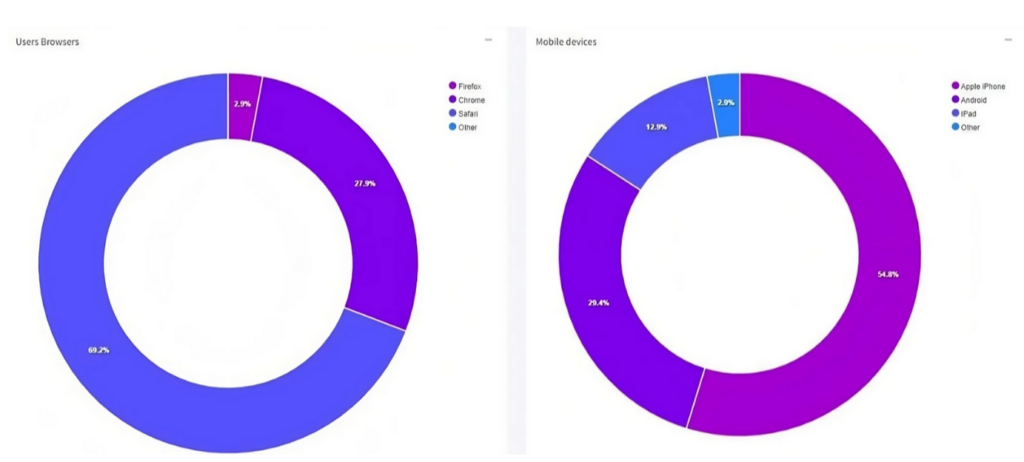Accessing free wifi in a hotel, bar, restaurant, shop or other public space is usually done in one of two ways.
Either you ask for the wifi password and type it into your device, or you’re presented with a captive portal web page (also called a splash page) before you gain access.
Well, this latter method of accessing the internet is known as captive portal wifi.
A captive portal is a webpage you must interact with before using a public or guest Wi-Fi network. You often see these in places like coffee shops, airports, and hotels.
When you try to connect to the Wi-Fi, the captive portal pops up and asks you to log in, agree to terms of service, or enter a password. This process helps the business manage who uses their Wi-Fi, ensure users agree to the rules, and sometimes collect feedback on services and products and show ads for marketing.
Once you complete the steps on the portal, you can access the internet. A captive portal also gives businesses increased control over their internet bandwidth since they can limit usage.
How a Captive Portal Works
When you connect to a Wi-Fi network with a captive portal, you first see a webpage that asks you to do something before you get internet access. Usually, you need to read and accept an acceptable use policy (AUP) by clicking a button to agree to the terms. This policy helps protect the Wi-Fi provider from legal issues if someone uses their network for illegal activities.
Sometimes, the captive portal will show ads you must click through or close before you can go online. In other cases, you might need to enter the username and password the provider gave you. This extra step helps prevent misuse of the network.
Most businesses require a captive portal authentication before giving visitors restricted access to the broader internet or a network’s resources.
Usually, a captive portal will not allow internet access over open wifi unless you have entered your details into a web-based form. Until this form has been completed, a user is classed as ‘captive’. Hence the name Captive Portal.
Of course, one of the main functions of a captive portal is to ensure access is restricted only to legitimate users. However, it also plays a vital role in capturing data, which can be used to create more meaningful user profiles for future marketing plans.
Another term you may come across is ‘social wifi’. This is because social media is now often used to access the internet via captive portal login, such as through Facebook or your Google account.
The Benefits of a Captive Portal
Captive portal design has other benefits, some of which we’ll cover here, besides data capture and restricting network and internet access to authorised users.
1. Capture Leads And Grow Your Marketing Database
The data obtained by a captive portal is a highly cost-effective way of capturing qualified leads and boosting the number of users in a customer database.
This quality data enables the creation of more customised campaigns. It’s also a speedy way of doing this, and the more visitors there are at a location, the quicker it becomes.
What Kind Of Data Can A Business Capture?
Although the type of user data captured via captive portal login can easily be customised to suit the needs of a business, it generally includes a user’s first name, surname, gender, location and age.
In some cases, a captive portal may also collect other information about the user, such as their IP address, the type of device they are using, or the URL of the website they are trying to access. The business network administrator can use this information to monitor usage and ensure the network is used properly.
However, it is essential to note that the information collected by a captive portal is generally limited to what is required for the user to access the internet and does not include personal or sensitive information.

2. Offer Customers a Seamless Wifi Experience
Captive portals can improve the user experience by providing a clear and simple way to access the Internet when connected to a public or guest Wi-Fi network.
This can be especially useful for users unfamiliar with wireless networks or who may not know how to connect to them otherwise.
Captive portals can help ensure that users can get online quickly and easily by providing a clear set of instructions and a simple way to access the Internet.
3. Promote Your Business
A captive portal splash page can promote a business by displaying information about the company and its products or services.
For example, a coffee shop could use its captive portal to display information about its menu, special offers, and upcoming events.
Additionally, the captive portal could provide links to the business’s website and social media profiles, allowing users to quickly learn more about the business and connect with it online.
4. Engage With Your Customers
A captive portal can promote a business, engage customers, and encourage them to interact with the business.
For example, the captive portal could include a survey or quiz that customers can take to provide feedback or learn more about the business.
The portal could also include links to games or other interactive content that customers can enjoy while they are waiting for their internet access to be granted.
Additionally, the captive portal could collect customers’ email addresses or other contact information, allowing the business to follow up with them and continue the engagement after they leave the premises.
5. Fully Customisable
Captive portals can be customised to meet a business’s specific needs and goals.
The captive portal’s appearance and content can be tailored to match the business’s branding and style. The portal can also be configured to display different information or offers depending on the time of day, the customer’s location, or other factors.
For example, a captive portal for a restaurant could display a special lunch menu during the day and a dinner menu in the evening.
Additionally, businesses can use captive portal software to track and analyse customer interactions with the portal, allowing them to continually improve and refine their approach to engaging customers.
Who Is A Captive Portal For?
Any business that provides its customers with internet access can benefit from using a captive portal to promote itself and engage with its customers.
These are just a few examples of businesses that could use a captive portal.
- Coffee shops
- Hotels
- Airports
- Libraries
- Retail stores and shopping centres
- Restaurants
- Bars and pubs
- Museums
- Gyms
- Cinemas
- Transportation hubs
- Stadiums and other venues
- Universities and schools
- Hospitals and healthcare facilities
- Caravan sites
- Conference centres
Are There Any Risks Associated With A Captive Portal?
One of the main risks is that because captive portals redirect all network traffic on a device to the login page, users may be vulnerable to man-in-the-middle attacks if they are not designed and implemented correctly. The attacker could intercept the user’s data and login information as it is transmitted between the device and the login page. A secure connection, such as HTTPS, can mitigate this risk.
Additionally, some captive portals may use insecure or outdated encryption methods to protect the user’s data, which could make it easier for attackers to steal sensitive information.
Finally, users may be at risk of downloading malware or malicious software from the captive portal login page if it is not adequately maintained or secured.
How To Set Up A Captive Portal Network
Setting up a captive portal solution usually requires an expert team. Performance Networks can help with configuring APs and setting up your landing page. Our solution, SupaFi, can be customised to your needs and requirements.
The easy-to-use back end also provides users with extensive data and analytics information. We can also help with setting up the authentication method, whether that is a simple password-based method or a more secure method like using a RADIUS server.
Once everything is set up, we will conduct extensive testing with you to ensure everything is set up correctly.
Captive portals are valuable tools for controlling network access. They allow network administrators to set up authentication, accept terms and conditions, or display custom messages to users before granting them access to the Internet.
If you are looking for a captive portal or guest WiFi solution, speak to a member of our team. We are experts in captive portal set-up and execution and can also help with existing captive portal solutions that no longer provide the needed service.





25 Responses
Tek adresim bu sitedir sonsuz güvenimi kazandınız teşekkürler
fethiye escort bayan bulma tanışma sitesi
Your blog post made me see [topic] in a whole new light. Thank you for broadening my perspective.
I’ve never commented on a blog post before, but I couldn’t resist after reading yours. It was just too good not to!
Your writing has a way of making complex topics seem approachable. Thank you for demystifying this subject for me.
Göcek escort bayan bulma tanışma sitesi
gerçek elden ödeme olan Fethiye Esc kızlar bu sitede yer alıyor
Hitako ny vokany, tena manoro hevitra aho fa indroa no voasoloky tamin’ny tranokala samihafa, saingy tamin’ity indray mitoraka ity dia hitako ilay tranokala notadiaviko, tena azo antoka.
medyum gerçekten ne dediyse oldu. Ve bu dedikleri ertesi gün gerçekleşti.Ben inanamadım bu olanlara.Bütün derdiniz sıkıntınız gidiyor.Hocamada ertesi gün dedikleri bir bir çıktığı için aradım.Müthiş bir medyumdur kendisi.
I’ve never commented on a blog post before, but I couldn’t resist after reading yours. It was just too good not to!
Your blog post was the perfect blend of informative and entertaining. I couldn’t tear my eyes away from the screen!
Your passion for this topic is contagious! After reading your blog post, I can’t wait to learn more.
баары жакшы рахмат
Tavsiye üzerine başvurdum , neden bu kadar geç kaldım diye kendime kızıyorum artık , sadece dinleyip hayatım değişti kesinlikle önyargılı olmayıp kendinize bir iyilik yapın.
في حين أنه حتى الطبيب لم يتمكن من حل مشكلتنا الصحية، فقد حلها الطبيب النفسي. لقد استغرق الأمر مني وقتًا طويلاً للعثور على هذا الموقع، لكنني وجدته أخيرًا، شكرًا جزيلاً لك.
Your blog post was the highlight of my day. Thank you for brightening my inbox with your thoughtful insights.
I just wanted to say how much I enjoyed reading your blog post. It’s rare to find such well-researched content that’s also a pleasure to read.
Your blog post has inspired me to delve deeper into this topic. Thank you for igniting my curiosity!
Merhabalar herkese tavsiye ediyorum çok işe yaradı
herkese merhabalar üç işlem yaptırdım şimdide ablam yaptırdı ailecek çok memnun kaldık
Çok memnun kaldım teşekkürler
hello!,I really like your writing so a lot! share we keep up a correspondence extra approximately your post on AOL? I need an expert in this house to unravel my problem. May be that is you! Taking a look ahead to see you.
Gracias por tu aportacion. Feliz semana. 😉
Muy buen aporte. muy recomendable! Reciba un cordial saludo!
Buenisimo el articulo. muy recomendable! Gracias!